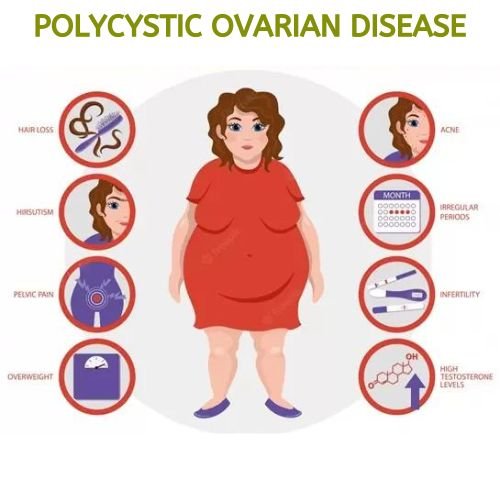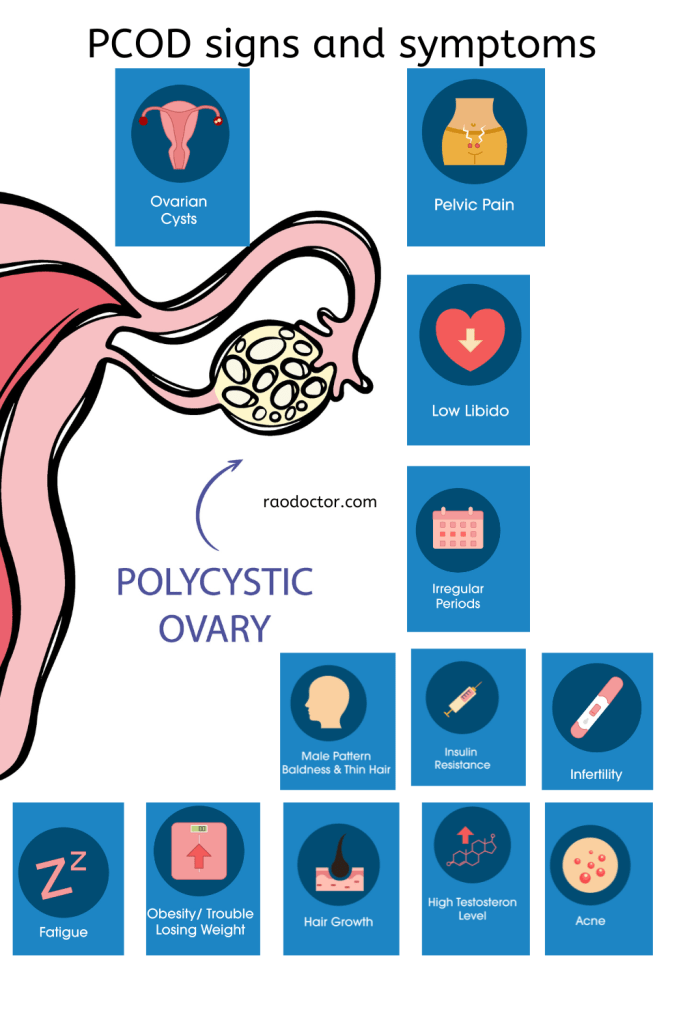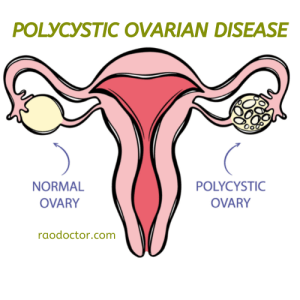Causes, signs, symptoms, complications and treatment

In my last article on Vitamin B12, I had mentioned at the end that my next article would be a one that affects women- Polycystic Ovarian Disease or PCOD. So, here I am, presenting this article dedicated to all the women in the world!
Polycystic Ovarian Disease (PCOD) or polycystic ovarian syndrome [PCOS] is a complex endocrine disorder that affects women of reproductive age.
Recently I wrote an article on Cervical Health Awareness Month– another important disease that affects women.
Global Statistics-
With the global food industry booming, there has been a rise in metabolic syndrome worldwide. Eating of junk foods, untimely food and sleep hours has led to hormonal changes in women causing weight gain and sex hormone changes- a decrease in estrogen levels and a rise in testosterone, prolactin, and luteinizing hormones.
Worldwide, it affects 4%–20% (8-40 crore) of women. In India, it affects 3.7% to 22.5% (1.3-7.9 crore) of women. TOI
PCOD can cause a range of symptoms, including irregular menstrual cycles, ovarian cysts, infertility, excess hair growth, weight gain, and acne.
It can also increase a woman’s risk of developing other chronic diseases, such as diabetes and heart disease.
Fortunately, there are treatments available to help women better manage the condition and improve their overall health.
This article will provide a comprehensive overview of PCOD, including its causes, symptoms, and treatments. It will also offer tips for managing PCOD and its potential complications.
With this information, women can take the necessary steps to better understand and manage PCOD.
What is Polycystic Ovarian Disease (PCOD)?
Polycystic ovarian disease, or PCOD, is a complex endocrine disorder that affects women of reproductive age. PCOD is caused by an imbalance in sex hormones and androgen production that leads to the formation of multiple small cysts on the ovaries.
It can cause a range of symptoms, including irregular menstrual cycles and infertility. PCOD can also increase a woman’s risk of developing other chronic diseases, such as diabetes and heart disease.
It can be challenging to treat, but there are treatments available to help women better manage the condition and improve their overall health.
It is a chronic condition that requires ongoing care. It is important to manage PCOD throughout one’s reproductive years and beyond.
It may first appear in adolescence, when menstruation begins. It also affects women in their twenties and thirties who are of child-bearing age. It also affects women who are entering menopause.
This is a common health problem. It affects an estimated 10 to 20 percent of women around the world [look above quote for statistics]. It occurs more often in women who have a family history of the condition.
Other risk factors include obesity and ethnicity. PCOD does not discriminate based on age, race, or socioeconomic status. It can affect women from all walks of life.
Causes of PCOD
There is no single cause of PCOD. Instead, it is a combination of genetics, environment, and lifestyle that leads to the development of the condition.
Research shows the following ailments as a cause-
- Hormonal Imbalance: The main cause of PCOD is an imbalance in sex hormones, primarily estrogen and androgen. Women produce small amounts of androgen, but women with PCOD produce excessive amounts of androgen.
- Dysfunction of the Hypothalamus: The hypothalamus is an area of the brain that controls the amount of hormones in the body. In women with PCOD, the hypothalamus may be unable to regulate hormones properly.
- Inherited Factors: PCOD may also be hereditary. Women who have a family history of PCOD may have a higher risk of developing it.
Signs and Symptoms of PCOD
SIGNS AND SYMPTOMS OF PCOD
This disease can cause a range of symptoms, including irregular menstrual cycles, ovarian cysts, infertility, excess hair growth, weight gain, and acne- see the picture below.
- Irregular menstrual cycles: Women with this disease may experience irregular menstrual cycles, such as missing a few periods or having more than one period per month. These women may get pelvic pain while menstruating- dysmenorrhea.
- Cysts on the ovaries: Cysts are sacs filled with fluid that form on the ovaries. In women with PCOD, the ovaries form multiple small cysts that usually do not go away on their own.
- Infertility: This disease can cause infertility by preventing a fertilized egg from implanting in the uterus.
- Excess hair growth: Women with PCOD may experience excess hair growth on their face, chest, and stomach. This is called hirsutism.
- Weight gain: This disease may lead to weight gain in some women.
- Acne: Some women with PCOD develop acne.
- Fatigue: Some women may feel excessive tiredness
- Weight Gain: Most cases of PCOD are overweight or obese.
- Sleep disturbance: Some cases may have excessive sleep; some may lack sleep making them all the more exhausted after waking up.
- Male Pattern Baldness– Some may develop loss of hair on the head.
- Infertility– Most women may find it difficult to conceive or low libido.

Diagnosis of PCOD
Women with PCOD may experience a range of symptoms. A doctor can use this information to make a diagnosis.
Blood Tests
To confirm a PCOD diagnosis, doctors may use blood tests to measure hormone levels and assess ovulation. These include the following hormones with their normal range-
- Follicle stimulating hormone (FSH): 1.5 – 12.5 mIU/ml
- Testosterone: 300 – 1000 ng/dL
- Luteinizing hormone (LH): 1.7 – 8.6 mIU/ml
- Prolactin: 2 – 18 ng/mL
- Dehydroepiandrosterone [DHEAS]: 0.8 – 4.2 ng/mL
- Thyroid Stimulating Hormone: 0. 40 to 4.5 mIU/ml
In most cases the value of prolactin, testosterone or LH is very high.
Ultrasound:
Ultrasound is a non-invasive imaging technique that uses high-frequency sound waves to create images of the inside of the body. Ultrasound is often used to examine the ovaries and look for cysts.
Imaging Techniques:
Imaging techniques, such as MRI and CT scans, can be used to look at the ovaries and surrounding tissues in more detail.
Treatment Options for PCOD
There are various treatment options available for women who suffer from PCOD.
- Hormonal Treatments: Hormonal treatments, such as birth control pills, are often used to regulate hormone levels and ovulation in women with PCOD.
- Ovarian Stimulation: IVF, or in vitro fertilization, is a type of ovarian stimulation treatment. It involves removing one or two eggs from the ovaries and combining them with sperm outside of the body.
- Ovarian Surgery: Surgical procedures, such as laparoscopic ovarian drilling, may be recommended to remove ovarian cysts.
- Stem Cell Therapy: Stem cell therapy, such as in vitro fertilization with donor eggs, uses the patient’s own stem cells to create healthy eggs.
- Lifestyle Changes: Making healthy lifestyle changes, such as eating a balanced diet and increasing exercise, may help manage PCOD.
Medications for PCOD
The medicines and dosage for PCOD vary depending on the individual, their symptoms and the severity of their condition. Generally, the following medications may be prescribed:

- Birth control pills: These are usually the first line of treatment, as they can help regulate hormones and reduce the symptoms of PCOD. I usually prescribe Ovral 21 one tablet per day.
- Metformin: This is a medication that can help reduce insulin resistance thus lowering blood sugar levels and body weight. I use Glycomet 500mg to 1000 mg per day depending upon the weight of the patient.
- Clomiphene citrate: This is an oral medication that can help induce ovulation and increase fertility in women with PCOD. Dosage- one Clofert/Fertomid tablet of 50 mg per day.
- Spironolactone: This is a diuretic medication that can help reduce androgen levels like testosterone in the body. Dosage- one 25mg tablet of Aldactone per day
- Dutasteride: This is an anti-androgen medication that can help reduce androgen levels in the body. Dosage- One 0.5mg tablet of Dutas per day
- Inositol: This is a nutritional supplement that helps in PCOD. Dosage- one 500 mg tablet of Myo Inositol per day
Useful Article – PCOS, Hashimotos’ and Obesity
Potential Complications of PCOD
PCOD can lead to the development of several long-term complications, including diabetes, heart disease, and endometrial cancer.
- Diabetes: Women with PCOD have an increased risk of developing type 2 diabetes.
- Heart Disease: Women also have have an increased risk of developing heart disease.
- Endometrial Cancer: Women with PCOD have an increased risk of developing endometrial cancer or endometriosis.
Tips for Managing PCOD
With the right treatment plan and lifestyle changes, women can manage PCOD successfully. Here are a few tips looking at that are worthwhile-
- Always Talk to Your Doctor: Women with PCOD should always speak with a doctor about their symptoms and treatment options.
- Stay Healthy: Stay healthy by getting enough sleep, eating a balanced diet, and exercising regularly.
- Stay Stress-Free: Managing stress can help women with PCOD better manage their condition.
- Protect Yourself from STDs: Protect yourself from sexually transmitted diseases, including HIV and HPV, by using condoms and getting tested regularly.
Final words
PCOD is a complex and challenging condition that affects many women. With the right treatment plan and lifestyle changes, women can manage this condition successfully.
However, it is important to always speak with a doctor about your symptoms and treatment options. Stay healthy by getting enough sleep, eating a balanced diet, and exercising regularly.
Stay stress-free by practicing relaxation techniques, maintaining a positive attitude, and surrounding yourself with supportive people.
Useful Resource-
If you have found this article useful-
Then please share it with your friends and relatives by clicking on the social share icons at the bottom of this article or Click to Tweet-
Polycystic Ovarian Disease Share on XMy next article will be on FAQs regarding Coronary Bypass Graft Surgery [CABG].




